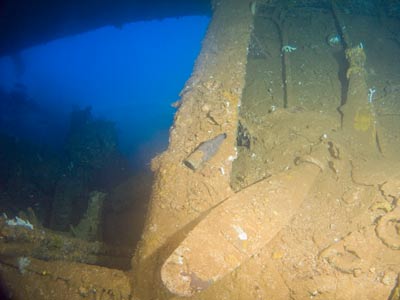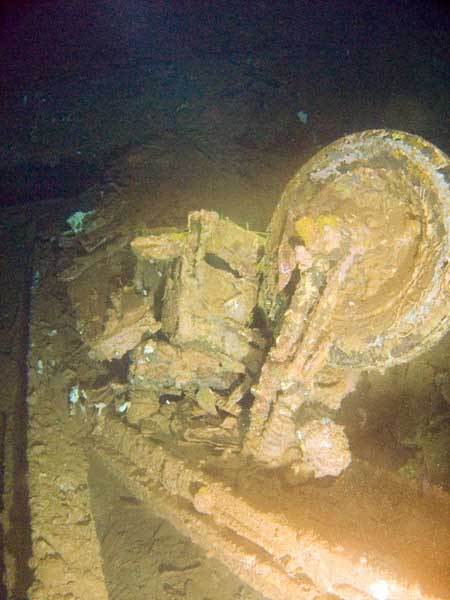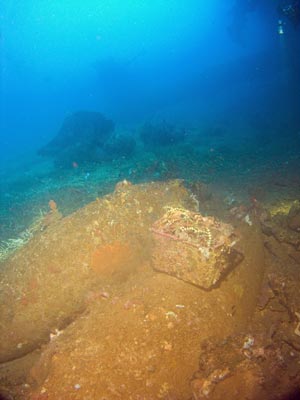|
Chuuk (Truk) Lagoon in the Federated States of Micronesia is frequently called Divers' Mecca or Divers' Heaven. This is not only because of the quality of the shipwrecks found here, but the quantity of wrecks. One of the wrecks is the Kikukawa Maru. This is a wreck that is rarely visited, not because it is not a good dive, but because there are so many other wrecks that are better known or more intact.
 |
| The Kikukawa Maru |
The Kikukawa Maru was built launched in December 1938 from the Kawasaki Heavy Industries shipyard at Kobe, Japan. The new ship was 108.1 metres long and 15.2 metres wide. The ship was a cargo/passenger vessel built for Kawasaki Kisen Kaisha displacing 3,833 tons. She was powered by two 1,000 hp steam turbines with the steam coming from coal heater boilers. Top speed was 14.9 knots and service speed 12.0 knots.
Unlike almost all the diveable wrecks in Chuuk Lagoon, the Kikukawa Maru was not sunk as a result of the US Operation Hailstone conducted over 17 to 18 February 1944. It was not even suck as a result of enemy action! On 7 October 1943 the Kikukawa Maru was in the process of being unloaded north-east of Eten Island. The cargo in its rear holds was primarily ammunition, although there may also have been fuel drums. Somehow, a fire started. Firefighting resources were sent to the location and started pouring water onto the holds.
 |
| Another photo of the Kikukawa Maru |
The fire was obviously hard to control and all of a sudden a massive explosion rocked the lagoon. The rear holds had exploded. The ship sank immediately, the rear third or so of the ship totally torn off and mostly evaporated. Not only was the Kikukawa Maru doomed, the firefighting boat the Ojima disappeared as did a number of other craft that appear to have been unloaded the ship at the time.
The force of this explosion must have been enormous. The wreck was first found in 1976 but then lost and refound again in June 1980.
Today the wreck is located at GPS Reading of N7ΒΊ 21' 26.5" E151ΒΊ 54' 43.1" using WGS84 as a datum. This will put you near the location of the bridge. The wreck is located on a sloping sand/broken coral bottom, with the eastern side shallower than the western side. The wreck lies roughly facing the south-west on her starboard side and is about 3/4 upsidedown.
 |  |
Kelly on the join of the hull bottom and
the port hull of the Kikukawa Maru | This is where the stern of the Kikukawa Maru has been blown away |
As the wreck is basically upsidedown, it is extremely hard to anchor on the wreck as the anchor has nothing to catch on unless your guide happens to get the anchor to run over the cracked hull area or the port railing area. When we dived the wreck in 2011, a number of attempts were made to anchor before the guide went down with the anchor (I had jumped in and confirmed I could make out the outline of the wreck) and eventually hooked us up.
Hailstorm Over Truk (see references) and its other documentation state that only one third of the wreck still remains and that only the section forward of the bridge is still there. However, I believe after diving the wreck that about two thirds remain and all the bridge is there.
 |  |
| This is the coal spilling from Hold 3 into Hold 2 | Adam Florence inside Hold 2 of the Kikukawa Maru |
As it was almost impossible to figure out which way the wreck lay and our guide had hardly ever dived it, at first we went the wrong way and ended up at the break in the hull. The hull has some massive ripples and indentations in it if you head towards the stern. Eventually you will come to the end of the wreck. There is a lot of other wreckage here as well.
I swear that there were two smallish propellers (much smaller than for a ship this size) and a bow section. This must be from one of the attending vessels that exploded, but the books on the Chuuk wrecks state that these are located further away.
To see the best part of the wreck, drop over the hulls till you can see the deck of the ship underneath. Turn left and this will take you to the bow. I did not examine the bridge area but forward of this is Hold 3. This appears to be mostly full of coal, presumably it is the coal bunker for the steam powered engine. We did not enter from outside, but looked at it from Hold 2. The coal actually spills into Hold 2.
 |  |
| Looking out of Hold 2 of the Kikukawa Maru | Another shot looking out of Hold 2, this time with aircraft propeller blades |
Forward is Hold 2. This is quite open and fairly well lit, despite being almost upsidedown. The rear of the hold is to the left and this is the bit that abuts Hold 3. It is a bit darker here but there is some light coming in through the deck. Hold 2 has lots to see. As well as coal spilling out from Hold 1, there heaps of aircraft parts, including radial engines, hundreds of propeller blades, aircraft bodies and propeller spinners. I counted at least 20 or so spinners and dozens of blades.
The hold also contains 200 litre drums, bottles and much, much more. Hold 1 can be entered from Hold 2. It has more of the same. At the very top back of the hold there are quite a few human bones. Also in this hold is what appears to be an upsidedown motorbike with a probable sidecar. There are also dozens of aircraft wheels and tyres.
 |  |
| One of many radial aircraft engines in Hold 2 | Some of he bones at the top of Hold 1 |
Forward in this hold towards the entrance are two seaplane floats for a fighter or reconnaissance aircraft. There are also possibly two more (of a different type) out on the sand. However, these might be aircraft fuel drop tanks.
The upper and back sections of this hold has hundreds of small timber boxes, about the size of a large shoe box. Some of these are broken or open, but there appears to be nothing inside now. I suspect that whatever was in them was vegetable in origin and it has now rotted away and all that remains is a black mush. There are similar boxes on the Sankisan Maru. I put my hand inside one and got a black filthy charcoal type substance on me. It is possible that this was charcoal for cooking fires for troops.
 |  |
| What appears to be a motorcycle and sidecar in Hold 1 | The two sea plane floats in the front of Hold 1 |
The bow of the Kikukawa Maru has two anchor chains that run out and back under the wreck. I suspect that the anchors are somewhere under the wreck, the explosion pushing the ship forward into the wind as it sank.
A return to the anchor via the highest part of the wreck (the join of the port hull and the bottom) minimise more decompression.
 |  |
| I think these are probably aircraft fuel drop tanks - just outside Hold 1 | Paul Pacey at the bow of the Kikukawa Maru |
This is a vastly underrated shipwreck, that very few people ever get the chance to dive. If you are going to Chuuk for more than 10 days, I would recommend that you dive here if possible. We did it as a second dive, but it could also be done as a first deeper dive.
Dives
References:
| 
 v6.00.307 © 2003-2005
v6.00.307 © 2003-2005